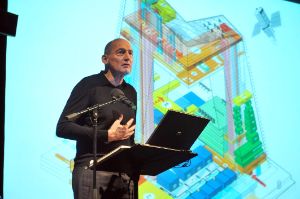Lecture
Rem Koolhaas
The Architecture of Difference
The Hermitage 2014 Project, St. Petersburg
Introduction: Joachim Sartorius

Rem Koolhaas © David Ausserhofer
A lecture by the architect
Rem Koolhaas – architect, urban planner, theorist and Harvard Graduate School of Design professor – is one of the most important and successful architects in the international arena. His work includes important contemporary buildings as well as major contributions to theory. He works internationally as an advisor and urban planner. According to Koolhaas: “The city is no longer. We can leave the theatre now.” This is the starting point for his conceptual work. He set up his Office for Metropolitan Architecture (OMA) in 1975, and began to translate social issues into architecture tailored to a changing world.
What defines our cities today? Is there an essential connection between people and the places where they live? In Delirious New York and S, M, L, XL Koolhaas – who was born in 1944 in Rotterdam – highlights images of the city disintegrating in the face of “bigness”. Many of his own projects aim for size: in 2008 he designed the spectacular 230 metre-high China Central Television Headquarters in Beijing, with an area of some 400,000 square metres. At present he is revamping the way the St. Petersburg Hermitage museum displays its three million works of art in 2,000 rooms – a project due to be completed in 2014 and amounting to nothing less than a complete redefinition of the museum. It is not Koolhaas’s intention, however, to provide a city with some kind of spectacular signature architecture à la Bilbao. Rather the idea is to redefine the relationship between a building and its urban context.